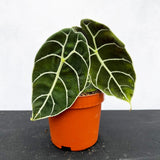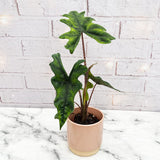New
50 - 60cm Alocasia zebrina Siberian Tiger Elephant Ear 19cm Pot House Plant
Alocasia Zebrina 'Siberian Tiger', a striking variant of the Alocasia Zebrina, is known for its distinctive zebra-striped stems and large, arrow-shaped leaves. It's a tropical plant that adds a dramatic flair to indoor spaces. Here's a detailed care guide for this unique plant:
Description
- Appearance: This plant is notable for its large, glossy, green leaves that resemble the shape of an arrow or a shield. The most distinctive feature is its stems, which have a striking pattern resembling zebra stripes, hence the name. The 'Siberian Tiger' variant often has a more pronounced striping pattern.
- Growth Pattern: Alocasia Zebrina 'Siberian Tiger' can grow to a substantial size indoors, with leaves potentially reaching over a foot in length. It typically grows upwards and can reach several feet in height.
Care Guide
-
Light Requirements:
- Prefers bright, indirect light. Direct sunlight can scorch the leaves, while insufficient light can cause the plant to become leggy.
- A location near an east or west-facing window is ideal, where it can receive filtered light.
-
Watering:
- Water when the top inch or so of the soil feels dry to the touch. It’s important to strike a balance as both over-watering and under-watering can be harmful.
- Ensure good drainage to avoid waterlogging, which can lead to root rot.
-
Humidity and Temperature:
- Thrives in a high humidity environment. If your home is dry, consider using a humidifier or placing the plant in a naturally humid area like a bathroom.
- Prefers temperatures between 18°C and 27°C. Protect it from draughts and sudden temperature fluctuations.
-
Soil and Fertilisation:
- Use a well-draining potting mix, ideally one that's rich in organic matter.
- Fertilise every 4-6 weeks during the growing season (spring and summer) with a diluted, balanced fertilizer. Less or no fertilization is needed in fall and winter.
-
Pruning and Repotting:
- Prune as needed to remove any yellowing or damaged leaves.
- Repot every 2-3 years or when the plant becomes root-bound. Use a pot only slightly larger than the previous one.
-
Pest and Disease Management:
- Keep an eye out for pests such as spider mites, aphids, and mealybugs. Treat infestations promptly with insecticidal soap or neem oil.
- Good air circulation and proper watering practices help prevent most diseases.
-
Propagation:
- Propagate by division. When repotting, you can gently separate the rhizomes, ensuring each division has at least one growing point.
Additional Tips
- Leaf Cleaning: Wipe the leaves occasionally with a damp cloth to remove dust and enhance photosynthesis.
- Rest Period: Alocasia Zebrina 'Siberian Tiger' may enter a dormant period in cooler months. During this time, reduce watering and stop fertilizing until growth resumes.
- Toxicity: The plant is toxic if ingested, so it should be kept away from pets and children.
Caring for the Alocasia Zebrina 'Siberian Tiger' involves providing a warm, humid environment and avoiding extremes in watering and temperature. With the right care, this eye-catching plant can be a beautiful and exotic addition to your indoor garden.
Check out our YouTube video to see exactly how we pack for safe delivery.
- Plants are supplied in plastic nursery pots unless stated in the product title.
- Plants are not for consumption unless stated as edible.
- Plant heights can fluctuate +/- 10%.
- Our plants are kept at our tropical nursery in Yorkshire where we maintain an average temperature of 18c.


































